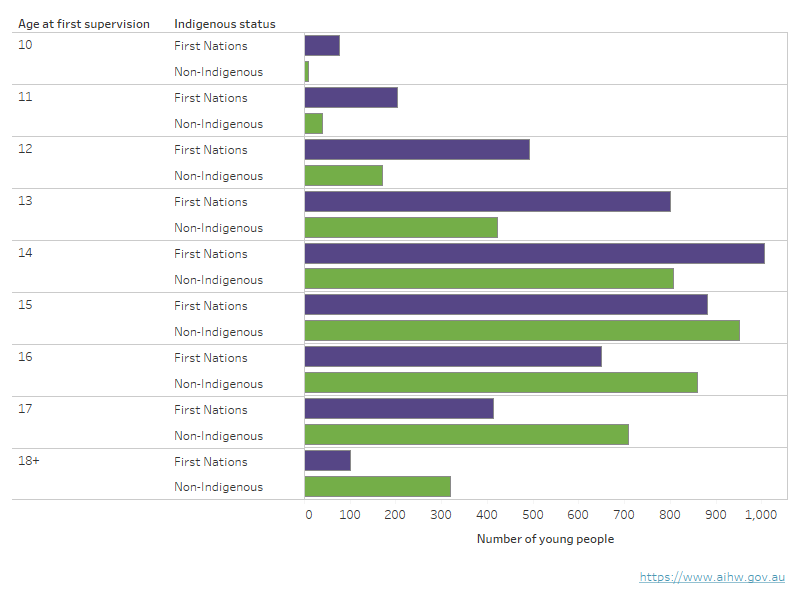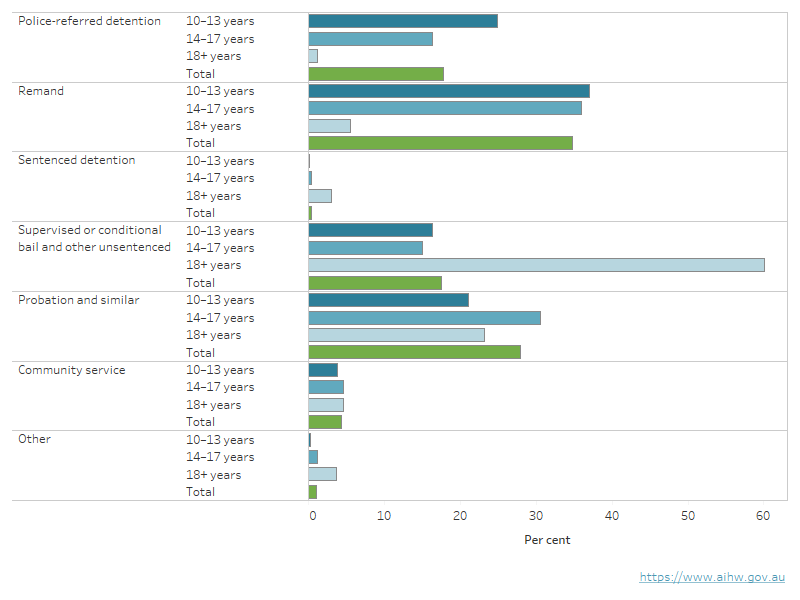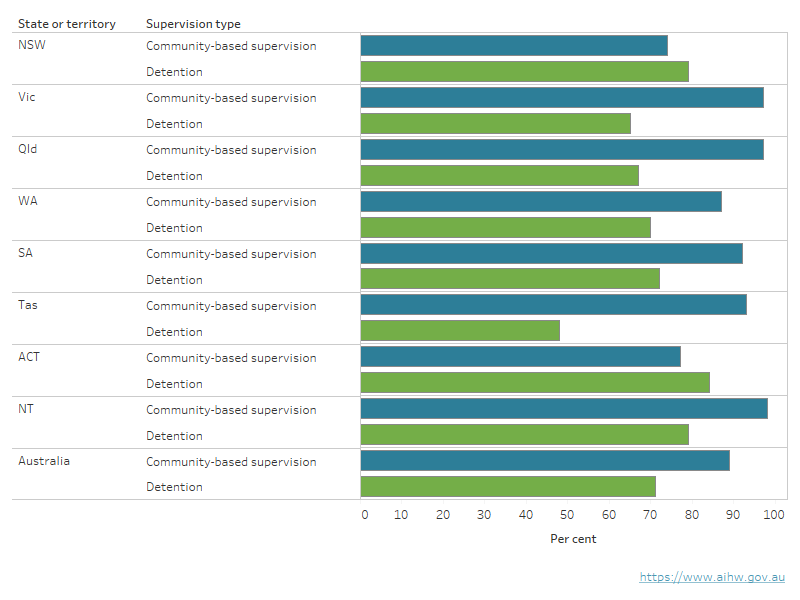Supervision history
First entry to supervision
First entry to supervision refers to the first time a young person came under youth justice supervision and includes periods of supervision that occurred before the reference period (2022–23).
Entry to supervision
About one-third (38%) of young people under youth justice supervision in 2022–23 were new to supervision in that year. The rest (62%) had been supervised in a previous year (Table S17). First Nations young people (66%) were more likely than non-Indigenous young people (61%) to have been under supervision in a previous year.
Of young people under community-based supervision, 67% had been supervised (under any type of supervision) in a previous year, compared with 56% of those in detention (tables S53 and S91).
Age at first supervision
Among all young people who were supervised during 2022–23 (Table S19):
- almost three-quarters (71%) had first entered youth justice supervision when they were aged 14–17
- about one-quarter (24%) had first entered supervision when they were aged 10–13
- 4.8% had first entered supervision when they were aged 18 and over.
Young people who were supervised in 2022–23 were most likely to be aged 14–17 when they first entered supervision in all states and territories, ranging from 64% in Western Australia to 81% in New South Wales (Table S19).
Western Australia had the highest proportion of young people who first entered supervision when aged 10–13 (36%), while Victoria had the highest proportion who first entered supervision when aged 18 and over (23%) (likely a result of Victoria’s ‘dual track’ sentencing system). The 10–13 years and 18 years and over age groups were not published for the Australian Capital Territory and Tasmania due to small numbers, in order to protect the confidentiality of young people.
On average, First Nations young people entered youth justice supervision at a younger age than non-Indigenous young people – more than a third (34%) of First nations young people under supervision in 2022–23 were first supervised when aged 10–13 compared with about 1 in 7 (15%) non-Indigenous young people (Table S19).
The most common age for first entry to youth justice supervision for First Nations young people was 14, compared with 15 for non-Indigenous young people (Figure 7.1).
Figure 7.1: Young people under supervision, by age at first supervision and Indigenous status, Australia, 2022–23

Note: Age on an average day is calculated based on the age a young person is each day that they are under supervision. If the age of a young person changes during a period of supervision, the average daily number under supervision will reflect this. Average daily data broken down by age will not be comparable with data in Youth justice in Australia releases before 2019–20.
Source: Table S18.
First type of supervision
Among all those who were supervised during 2022–23, the most common first types of supervision were remand (a type of unsentenced detention) at 35%, and probation and similar (a type of sentenced community-based supervision) at 28% (Figure 7.2).
For young people entering supervision for the first time when aged 10–13, the most common types of supervision were probation and similar, police-referred detention and remand (Figure 7.2).
For those entering supervision for the first time aged 14–17, the most common type of first supervision was probation and remand.
For those entering supervision for the first time aged 18 and over, the most common type of first supervision was supervised or conditional bail (and other unsentenced supervision).
Very few young people under youth justice supervision were given sentenced detention as their first type of supervision (less than 0.4% overall, and 3.0% of those aged 18 and over).
Figure 7.2: Young people under supervision, by type of first supervision and age at first supervision, Australia, 2022–23
This horizontal bar chart shows the first type of supervision that young people received by age at first supervision. Young people aged 14–17 at first supervision were the most likely to have received probation and remand as their first supervision type.

Notes
- Numerators are the number of young people who were under a given type of supervision by age group of first supervision (Table S20). Denominators are the total number of young people under supervision during the year by age group of first supervision (Table S19).
- Age on an average day is calculated based on the age a young person is each day that they are under supervision. If the age of a young person changes during a period of supervision, the average daily number under supervision will reflect this. Average daily data broken down by age will not be comparable with data in Youth justice in Australia releases before 2019–20.
Sources: tables S19 and S20.
Youth justice supervision history
About 9 in 10 (89%) young people who were supervised during 2022–23 had been under community-based supervision at some time during their supervision history (either during 2022–23 or in a previous year) (Figure 7.3). More than two-thirds (71%) had spent time in detention.
About 3 in 5 (60%) young people under supervision during 2022–23 had been under both community-based supervision and in detention at some time during their supervision history.
About 3 in 10 (29%) had been under community‑based supervision only, and 11% had been only in detention (tables S2b, S33k and S33o).
Among the states and territories, the proportion of young people supervised during 2022–23 who had been:
- under community-based supervision at some point during their supervision history ranged from 74% in New South Wales to 98% in the Northern Territory
- in detention ranged from 48% in Tasmania to 84% in the Australian Capital Territory (Figure 7.3).
Figure 7.3: Young people under supervision during the year, by supervision history and State or territory, 2022–23
This horizontal bar chart shows the proportion of young people who had a history of supervision prior to their most recent period of supervision. In all states and territories, except for the Australian Capital Territory and New South Wales, a prior history of community-based supervision was more common than detention.

Notes
- Numerators are the number of young people who had a supervision history containing any type of community-based supervision
(Table S33c) or detention (Table S33g), by state and territory. Denominators are the number of young people under supervision during the year, by state and territory (Table S2b). - Supervision history was not available for all young people under supervision (see Appendix A).
Sources: tables S2b, S33c and S33g.
Similar proportions of males and females under youth justice supervision during 2022–23 had been under community-based supervision at some point during their supervision history (89% and 88%, respectively). Males (72%) were slightly more likely than females (67%) to have previously been in detention (tables S2b, S33c and S33g).
Similar proportions of First Nations and non-Indigenous young people under supervision in 2022–23 had been under community-based supervision at some time during their supervision history (90% and 89%, respectively) (tables S2b and S33c).
Just over 3 in 4 First Nations young people (76%) under supervision during 2022–23 had a supervision history containing any type of detention. About two-thirds (68%) of non‑Indigenous young people had a supervision history containing any type of detention (tables S2b and S33g).


